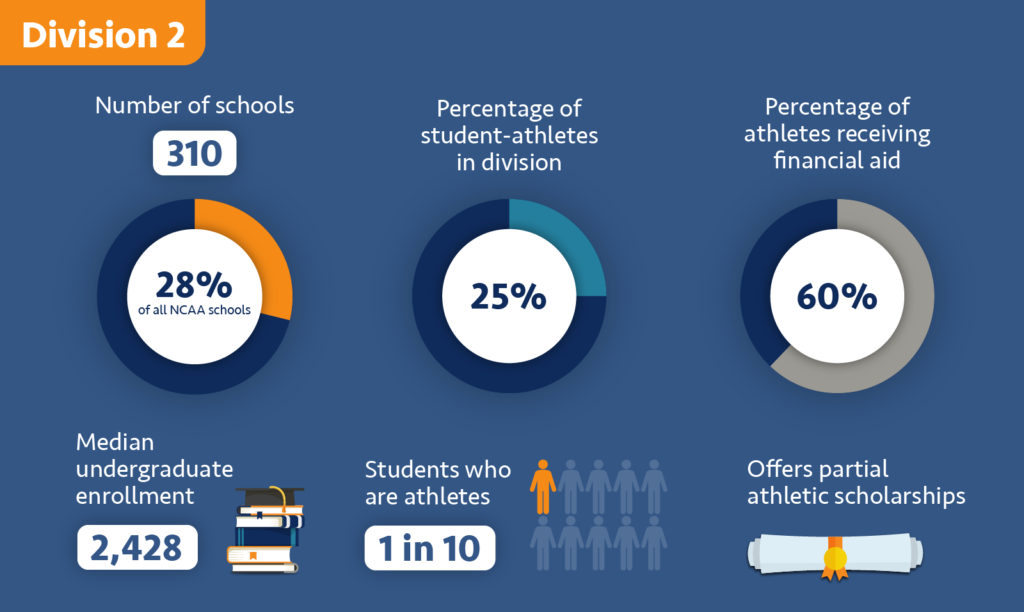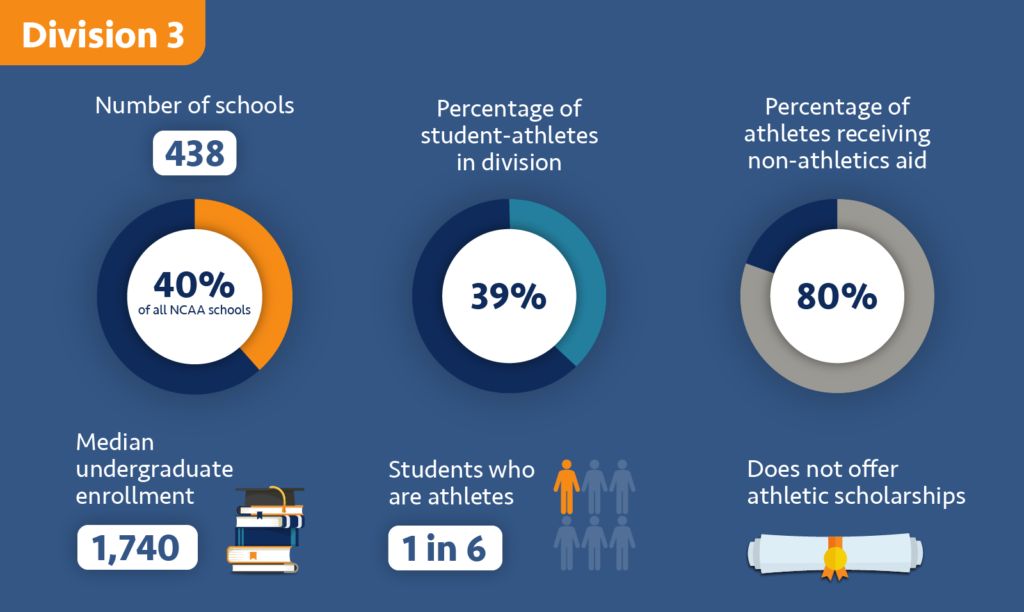what 4 requirements must a college or university meet in order to join the ncaa?
The Difference in the College Division Levels

Co-ordinate to the NCAA, there are 350 Division 1 schools, 310 Division 2 schools, and 438 Division iii schools. To requite you a better thought of size and how these divisions compare, about 176,000 pupil athletes compete at the Division one level. A little more than 118,000 educatee-athletes compete in Division 2 and Division iii has simply nether 188,000 student athletes on its diverse rosters. And that's just the NCAA divisions. There'due south as well the National Clan of Intercollegiate Athletics (NAIA) with more 250 schools and of class many options at the junior higher level for high school athletes. While there are some similarities, y'all'll detect each college option is somewhat unique.
For example, one difference is that all D1 and D2 athletes must meet certain eligibility requirements set by the NCAA. Division 3 eligibility requirements are set by the school.
Quick Links
Student-athletes and parents should note that for the small-scale per centum of high school athletes that end up playing at the D1 and D2 level, but about 57 percent of D1 athletes receive some type of athletics help and D2 athletes fare merely a little meliorate at 60 percent that get athletics aid.
Here are a few things to consider when comparing NCAA sectionalization levels:
Back to Top ^
The surprising DIII deviation
While D3 schools do not offer any type of athletic scholarships, parents volition be pleased to know that 80 percent of D3 athletes receive not-athletics aid, often in the form of grants or need-based scholarships to academically qualified athletes. Another big plus for both parents and pupil-athletes is that 87 percentage of all D3 athletes graduate from college. Although the other two divisions are not that far behind, that'south the highest per centum of any NCAA Division.
Back to Meridian ^
What'south it really like?
At that place are plenty of facts and figures near each division, but they merely tell part of the story, or may requite the wrong impression. For example, the rank lodge of the divisions may imply to some that anything beneath a Division I plan is somehow settling for second best. While it'southward true D1 offers a higher level of competition and is home to some of the largest and almost prestigious schools in the state, information technology does not hateful in that location are not stellar opportunities to compete at earth-course colleges in divisions ii and 3.
Many high schoolhouse athletes who have the concrete size, athleticism, and grades to compete at the D1 level opt to go to a D2 or D3 school for a diverseness of reasons. It may be that they just wanted to go to a smaller school, stay closer to domicile, or a adventure to report abroad. And for some, they simply didn't want their college experience defined past the enervating lifestyle of a DI athlete. What colleges offer full ride scholarships?
View NCSA's list of the Best Colleges for educatee athletes.
As your athlete begins to look at their college options, it's of import to understand the dissimilar higher experiences for athletes in D1, D2 and D3 programs. Here'south a quick breakup of what to look:
Back to Top ^
Sectionalization I: Your sport, your life

For NCAA Sectionalization i athletes, the rewards are many. Competing at a large academy in front big crowds against some of the best athletes in your sport. Simply only know the competition for your spot on the team is fierce and your time is not your own–that includes weekends and off season. Practice, training, travel, and study. There's also volunteer work.You will be tired. Internships, spring break getaways, even part-time jobs are pretty much out of the question. The D1 athlete is truly defended to their sport for the adjacent iv years. For some, it tin can be overwhelming-even exhausting. But almost every one would say they would non trade their D1 experience for anything.
View NCSA's list of the All-time NCAA Division 1 Colleges for educatee-athletes.
Back to Top ^
Division I and the Ivy League 8
Some of the oldest and most prestigious schools in the land brand up the Ivy League. Brown University, Columbia, Cornell, University of Pennsylvania, Harvard, Princeton, Yale and Dartmouth rank among the top xx NCAA Segmentation ane schools. More than viii,000 student-athletes compete every year for these schools. Most choose the Ivy League for its ultra-high level of competition in both athletics and academics. If an Ivy League school is on your target list, just note that these schools do not laurels academic or athletic scholarships. Financial aid is based on demand determined by the Financial Aid Function at each school.
Insider tip: Time management is central. Learn from a onetime D1 how you tin can manage your workload meliorate with these Nine Fourth dimension Management Tips.
Back to Height ^
Partitioning II: A more than balanced arroyo

Student-athletes who want a loftier level of competition but a more balanced approach to sports and academics are giving serious consideration to D2 schools. It's as well perfect for those who may adopt a smaller campus, or the opportunity to go playing time all four years. Every bit one recruit put it, "I'd rather be a big fish in a smaller pond." There are nonetheless the demands all student-athletes face, but it is non every bit intense and rigorous every bit the year-round full commitment of a D1 athlete.
View NCSA's list of the Best NCAA Segmentation 2 Colleges for educatee-athletes.
Back to Superlative ^
Sectionalisation 3: A well-rounded higher experience

D3 programs offer a more well-rounded college feel where academics accept more of the lead. Just like their D1 and D2 counterparts, D3 athletes likewise must learn to manage playing their sport while pursuing their education. The time commitment, however, for D3 athletes is not nearly every bit intense which gives them more opportunity to explore life outside of the classroom and exterior of their sport. D3 athletes often feel they are more a role of the general college community where D1 and D2 athletes feel a little more separated from the rest of the higher or university.
View NCSA'southward list of the Best NCAA Partitioning 3 Colleges for pupil-athletes.
Dorsum to Acme ^
Why an NAIA schoolhouse might be your best bet

It may come as a surprise to some simply the National Association of Intercollegiate Athletics (NAIA) has actually been effectually longer than the NCAA. With most 250 mostly private, smaller schools, more lx,000 student-athletes compete at NAIA colleges in a diverseness of popular sports. Many consider NAIA to be on par with NCAA D3 schools when it comes to life/sport residuum and level of competitiveness. The NAIA awards close to $500 one thousand thousand in athletic scholarships every twelvemonth. That, along with more than ambitious recruiting is driving more talent to these schools and bringing up the level of contest. Today, top-level NAIA schools are considered to be similar to competing on a NCAA D2 squad. Learn more about the NAIA and how it differs from the NCAA below:
Read more NAIA Schools: What You Need to Know
View NCSA's listing of the Best NAIA Colleges for student-athletes.
Back to Summit ^
Don't ignore junior colleges
Between the three NCAA divisions and NAIA schools, it's like shooting fish in a barrel for recruits to overlook junior college athletics as an option. Even so, co-ordinate to the National Junior College Athletic Clan (NJCAA) almost sixty,000 pupil-athletes participate in 28 unlike sports at 500+ schools nationwide–every year.
Many recruits laissez passer on considering a junior college considering there are many common misconceptions most what junior colleges can offer educatee-athletes. However, today'south junior colleges have a lot to offer, especially when it comes to scholarships and other price-savings.
For some athletes, junior college is the best path to getting a four-year college roster. For others, information technology'due south a chance to stay shut to home, earn college credit, and continue on with their athletic career. Hither are four reasons why inferior colleges can be a bully option for educatee-athletes:
Looking for more reasons to consider attending a junior college or pursuing junior college athletics? Here are a few more advantages of a inferior college that other partitioning levels may non have:
- They're more than affordable (and offering athletic scholarships!). Not only are junior colleges less expensive than public and private iv-twelvemonth colleges and universities, they also tend to be more generous with academic and athletic scholarships.
- It'due south more practical than taking a year off. It is extremely difficult (if not impossible) to get recruited to play at a four-yr college afterwards taking even one gap yr between loftier school and college.
- Recruits can make an impact right away. Junior college athletics coaches expect for players that can hit the basis running and may even recruit for starting roles. No benchwarmers here!
- Increment your chances of getting recruited at a 4-year college. Higher coaches like to recruit JUCO athletes because they're a safer bet than their high school counterparts: coaches know these athletes can already remainder college academics and athletics while maintaining their eligibility.
While nearly everyone starts out thinking D1 is the ultimate goal, it really comes down to what type of college experience will be right for your child. The expert news is that with three NCAA divisions, NAIA schools and junior colleges, there's something for every blazon of student-athlete.
Back to Tiptop ^
How to gauge your talent to discover your best division
One of the first steps in the recruiting process is to accurately judge your talent level and go an agreement of the divisions y'all might be suited for athletically. Still, each day, we talk to athletes who don't take a practiced grasp on what's realistic for them.
And we get it! It's tough to predict what level yous'll be at in 3 or even 2 years. The good news: There are plenty of means to effigy out where you stand athletically. The bad news: Information technology'due south withal going to require that you honestly evaluate yourself. Permit'south cheque out some of the all-time ways to get a meliorate understanding of your true athletic talent.
Watch college games at every sectionalisation level
Watch college athletes closely and compare your current skill level to the competition. If yous can, visit local schools and universities and see information technology live. And be realistic! If you need to improve drastically in lodge to get some playing fourth dimension on a team, it might make sense to check out a game at a unlike partitioning level and encounter how y'all compare.
Watch higher athletes closely and compare your current skill level to the competition. If you lot tin, visit local schools and universities and see information technology live. And be realistic! If you need to improve drastically in order to get some playing time on a squad, it might make sense to check out a game at a different division level and come across how you compare.
The head baseball passenger vehicle at Webster University explained during a panel discussion, "Go watch a Sectionalization i, a Division 2, a Division 3 or an NAIA game." He added, "One of the all-time things I did—I played at Quincy University—I went and watched them play. I sat in the stands and said, 'You know what, I can play hither; I can practice this.' I also went and saw Illinois Country play the Academy of Northern Iowa when I was in high schoolhouse, and I thought, 'Well, maybe not.' Not that I wasn't equally good, only I wasn't going to play… And I knew I wanted to play every twenty-four hours."
When yous're watching a game, ask yourself these questions to aid you figure out if this is the correct level for you:
- Could you compete with these athletes today? If not, are y'all on rails to exist at that level as a senior?
- Would y'all get playing fourth dimension if you joined this team? Is playing time important to y'all?
- Tin you picture yourself competing on this team and for this school?
Review rosters of schools at different partitioning levels
There's a lot of helpful information you lot can get from a higher sport's roster. To find it, become to the school'south website and find the roster of electric current squad members. Typically, y'all can find information technology past searching for the able-bodied program and then your specific sport. Each athlete volition nearly probable have a short bio that talks about their loftier school and collegiate accomplishments. Here are a few primal things to await for:
- Check out the body types of the athletes in your position. How do y'all stack upwardly to their posted heights and weights?
- Are you competing in the same tournaments and showcases as the current athletes?
- Review their list of high school accolades (e.g., All-State, All-City, squad MVP or captain), and consider how your current compilation of accolades compares.
- For individual sports like runway & field, pond, etc., pay particular attention to the athletes' current stats. Compare that to your current numbers
Keep an open mind as you're looking through schools' rosters. If you never imagined yourself competing at a D3 school—but those are the athletes who most resemble you—it'southward worth it to continue investigating what that division has to offer.
Hint: In that location are endless benefits to attending a D3 school. Learn more about D3 colleges and universities.
Get evaluated by a third party
In many cases, it's almost impossible to objectively evaluate yourself, especially on something equally personal as your athletic talent. That's where third parties come into play. Experts tin can either evaluate you lot in person or via your highlight film. If you use flick, make certain it'due south upward to appointment.
Yous can ask your current high school and/or club coach to evaluate your talent level. Recruiting experts, similar Next Higher Student Athlete, provide evaluations for athletes in 31 different sports. Another avenue to investigate are evaluation camps. They are, equally the name indicates, camps for higher hopefuls in which coaches aid athletes estimate their talent and requite them suggestions on how to improve.
When getting a third-party evaluation, here are a few questions to ask the evaluator:
- What level do you think I could compete at right now?
- How much would I need to ameliorate to get to the side by side level?
- What are my strengths? What weaknesses should I piece of work on?
Compete against elite athletes
Some high schools and clubs compete against tough teams who notoriously turn out college athletes. For athletes who already compete against the aristocracy, every game is an opportunity to level set and see how they compare to other athletes in their recruiting grade. Some athletes, nevertheless, play for smaller teams and don't necessarily get a hazard to compete against other college-spring athletes. In this case, it's crucial to observe camps, showcases, summer leagues or club teams that provide an opportunity to play against the best loftier school athletes.
Getting a improve understanding of your talent is a cracking identify to start when figuring out your best school. Yet, don't forget that a great match is about where you fit athletically, academically and socially. You may have the talent to compete at the Division 1 level, but that doesn't hateful that will be the all-time fit for yous academically and socially. Keep all three factors in heed every bit you build your target list of schools, visit campuses and exercise your research.
Dorsum to Top ^
Source: https://www.ncsasports.org/recruiting/how-to-get-recruited/college-divisions
0 Response to "what 4 requirements must a college or university meet in order to join the ncaa?"
Enregistrer un commentaire